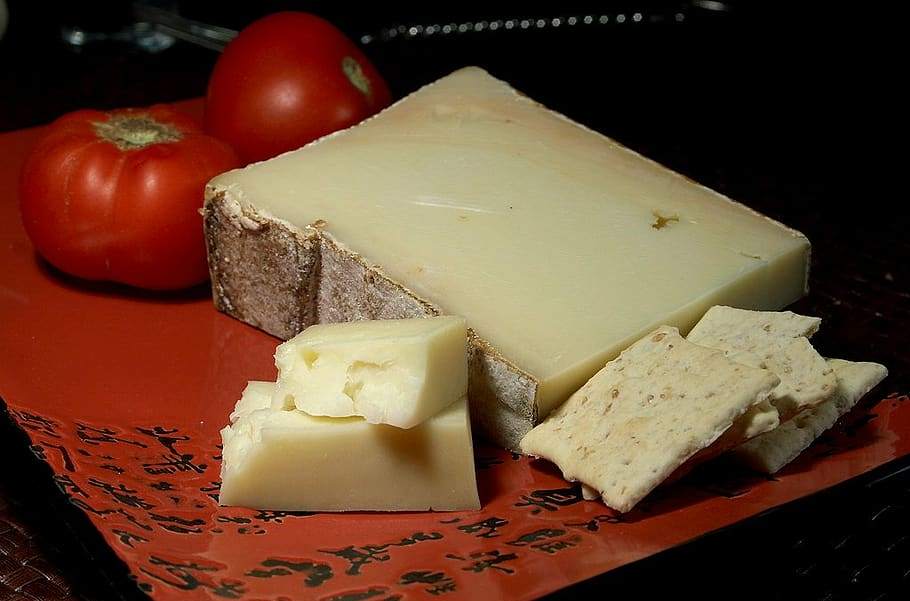Are you a cheese enthusiast seeking to explore the world of bold and robust flavors?
Well, look no further than the realm of hard cheese.
With its firm texture, aged to perfection, and bursting with savory notes, hard cheese is a captivating culinary delight.
From Parmigiano-Reggiano to Grana Padano, discover the intriguing world of these delectable, long-aged cheeses that are sure to elevate your taste buds to new heights.
what is hard cheese
Hard cheese is a firm type of cheese that can be categorized into hard and semi-hard varieties.
It is made by separating and draining most of the whey before pressing the curd.
The curd is then either brined or waxed, and the cheese is aged for two to 36 months, or even longer.
Hard cheeses are dense, savory, and often have strong notes of hazelnut and sautéed butter.
They have a mild tang, followed by a sharp and aromatic finish.
The texture is granular and firm, and the cheese often forms natural salt crystals with age, resulting in a crumbly body.
Many hard cheeses develop a tough rind that adds flavor when mixed into soups, sauces, and stews.
Some examples of hard cheeses include Parmigiano-Reggiano, Pecorino, Manchego, and Grana Padano.
Parmigiano-Reggiano is sharp and intense, aging for at least 12 months, while Pecorino is slightly milder with notes of spice and caramelized butter.
Manchego is nutty with hints of sweet fruit and spice, made from sheep’s milk, and Grana Padano is similar to Parmigiano-Reggiano but milder in taste, requiring only 9 months of maturation.
Key Points:
- Hard cheese is categorized into hard and semi-hard varieties.
- It is made by separating and draining most of the whey before pressing the curd.
- Hard cheeses are aged for two to 36 months or longer.
- They have a dense, savory taste with strong notes of hazelnut and sautéed butter.
- The texture is granular and firm, often forming natural salt crystals with age.
- Hard cheeses like Parmigiano-Reggiano, Pecorino, Manchego, and Grana Padano have specific flavors and aging requirements.
what is hard cheese – Watch Video
💡
Pro Tips:
1. Hard cheese trivia: Did you know that hard cheese actually contains less lactose than softer cheeses? The fermentation process used to make hard cheese removes much of the lactose, making it more tolerable for those with lactose intolerance.
2. Hard cheese trivia: Parmigiano-Reggiano, one of the most famous hard cheeses in the world, is made using only three ingredients: cow’s milk, salt, and rennet. No artificial additives or preservatives are used in its production.
3. Hard cheese trivia: Cheddar cheese, a popular type of hard cheese, originated in the small village of Cheddar in Somerset, England. The unique process of maturing the cheese in caves led to its distinct flavor and texture.
4. Hard cheese trivia: The world’s most expensive cheese ever sold is called Pule, and it is a hard cheese made exclusively from the milk of Balkan donkeys. This rare and luxurious cheese can cost up to $600 per pound!
5. Hard cheese trivia: Some antique hard cheeses, like the Västerbottensost from Sweden, are aged for several years to enhance their flavors. The production of this cheese is so exclusive that only one dairy in the world is allowed to produce it, making it a true culinary gem.
Definition of Hard Cheese
Hard cheese is a type of cheese that falls into the category of both hard and semi-hard varieties. It is known for its firm texture, which is achieved by separating and draining most of the whey before pressing the curd. The curd is then either brined or waxed, and the cheese is aged for a period ranging from two to 36 months, or even longer in exceptional cases. The aging process significantly impacts the flavor, with well-aged cheese being less creamy and having a grainier texture.
Some key points to note:
- Hard cheese is categorized as both hard and semi-hard.
- The texture of hard cheese is sturdy.
- Whey is removed before pressing the curd to achieve a firm texture.
- The curd is either brined or waxed.
- Hard cheese is aged for a period of time, ranging from two to 36 months.
- Well-aged hard cheese has a less creamy texture and a grainier consistency.
“The aging process plays a crucial role in determining the intensity of the flavor.”
Making Process of Hard Cheese
The process of making hard cheese is meticulous and involves several steps:
-
Separation of whey from the curd: The curd is formed by adding a starter culture, rennet, and sometimes calcium chloride to milk. The milk is then heated and left undisturbed until the curd has firmly coagulated.
-
Cutting and stirring the curd: Once the curd is ready, it is cut into small pieces and gently stirred while being heated. This helps to expel additional whey and create a more compact texture.
-
Draining the whey: After the whey has been drained, the curd is transferred to molds and pressed to remove any remaining moisture. The length and pressure of the pressing process vary depending on the desired texture of the cheese.
-
Enhancing flavor and preserving the cheese: Some hard cheeses are brined, which involves submerging the cheese in a saltwater solution to enhance its flavor and preserve it. Others are coated in wax to protect them during the aging process.
-
Hard cheese making involves a meticulous process.
- Starter culture, rennet, and calcium chloride are added to milk to form curd.
- Curd is cut into small pieces and stirred while being heated.
- Whey is drained and curd is pressed to remove moisture.
- The pressing process varies based on desired texture.
- Some hard cheeses are brined in saltwater solution to enhance flavor and preserve them.
- Others are coated in wax for protection during aging.
Note: The making of hard cheese requires precision and attention to detail.
Aging and Flavor Profile of Hard Cheese
The aging process is critical in developing the distinctive flavors and textures that make hard cheese so beloved. Hard cheeses can be aged for extended periods, allowing them to develop complex flavor profiles. As they mature, the flavors become more intense, and the cheese itself becomes less creamy and more granular in texture.
This aging process also facilitates the formation of natural salt crystals in the cheese, resulting in a slightly crumbly body.
- Aging process is critical in developing flavors and textures
- Long aging periods allow for complex flavor development
- Cheese becomes less creamy and more granular with age
- Natural salt crystals form, giving the cheese a slightly crumbly body
Characteristics of Hard Cheeses
Hard cheeses are characterized by their dense and savory nature. They often exhibit strong notes of hazelnut and sautéed butter, which contribute to their unique taste. The granular and firm texture sets them apart from other cheese varieties. Many hard cheeses also develop a tough rind that adds additional flavor when used in cooking, as it can be grated or melted into soups, sauces, and stews.
Umami Taste and Tangy Notes in Hard Cheeses
One of the main reasons why hard cheese is so popular is its umami taste. Umami is known as the fifth taste sensation, alongside sweet, sour, salty, and bitter. Hard cheeses have a mild tang that is often followed by a sharp and aromatic finish. This distinct combination of flavors makes hard cheese both versatile and appealing to a broad range of palates.
Textural Qualities and Salt Crystals in Hard Cheese
The textural qualities of hard cheese are highly prized by cheese enthusiasts. The granular and firm texture gives the cheese a unique mouthfeel that is satisfyingly chewy. With time, hard cheeses often form natural salt crystals, which contribute to their overall texture and enhance the eating experience. These small crystals provide a delightful burst of flavor when biting into the cheese, adding an additional layer of enjoyment.
Importance of Tough Rind in Hard Cheese
Most hard cheeses develop a tough rind as they age. This rind serves several purposes. It can protect the cheese during its long aging period, keeping it safe from external contaminants. Additionally, the rind can imbue the cheese with additional flavors and aromas, enriching its overall taste. When grated or melted into dishes, the rind can infuse soups, sauces, and stews with a concentrated burst of flavor that enhances the overall culinary experience.
Examples of Popular Hard Cheeses
There are numerous varieties of hard cheeses, each with its own unique characteristics that contribute to its popularity. Parmigiano-Reggiano, known as the “King of Cheese,” is renowned for its sharpness, intensity, and full-bodied flavor. It ages for a minimum of 12 months, resulting in a cheese that is complex and highly sought after.
Pecorino is another popular hard cheese, slightly milder than Parmigiano-Reggiano, and known for its notes of spice and caramelized butter. The nutty Manchego, made from sheep’s milk, delights the palate with hints of sweet fruit and spice. Grana Padano, similar to Parmigiano-Reggiano but milder in taste, requires only nine months of maturation and offers a delightful balance of flavors.
In conclusion, hard cheese is a firm and dense type of cheese that undergoes a meticulous preparation and aging process. It possesses a unique flavor profile, characterized by strong notes of hazelnut and sautéed butter, and is praised for its umami taste, tangy notes, and deep aromas. Its granular texture and the formation of natural salt crystals contribute to its distinctive qualities. Moreover, the tough rind of hard cheeses adds depth and enriches various culinary creations. With its popularity and versatility, hard cheese has become a beloved choice for cheese connoisseurs and food enthusiasts alike.
💡
You may need to know these questions about what is hard cheese
What are examples of hard cheese?
Swiss cheese and provolone are excellent examples of hard cheeses. Swiss cheese is known for its distinctive holes and nutty flavor, while provolone is recognized for its smooth texture and slightly tangy taste. These hard cheeses, like Parmigiano and Cheddar, are packed with a variety of nutrients such as fat, protein, and essential minerals like calcium, phosphorus, and sodium. They not only add depth to dishes but also provide a hearty dose of nutrition.
Is Swiss cheese considered a hard cheese?
Swiss cheese is actually considered a semi-hard cheese. Similar to other cheeses in this category, like Cheddar, Gouda, and Edam, Swiss cheese has a lower moisture content and is aged for a longer period of time. It is known for its distinctive holes and smooth texture, making it a popular choice for sandwiches and fondue.
What is meant by hard cheese?
When discussing hard cheese, we refer to a type of cheese that possesses a pronounced and intense taste. This variety stands out due to its concentrated flavors, which are further enhanced as it ages over time. The secret lies in its low moisture content, which allows for prolonged preservation while also contributing to the development of intricate flavors and characteristics. The production process involves cutting the curd into fine pieces before subjecting it to high temperatures, reaching up to 55°C. This meticulous process results in the creation of a cheese with exceptional depth and richness.
Is mozzarella a hard cheese?
Mozzarella is not considered a hard cheese but rather falls under the category of semi-soft cheese. This delicacy has its roots in Italy, initially crafted from water buffalo milk, but more commonly produced using cow’s milk today. With its elasticity and superb melting abilities, mozzarella has become the iconic choice for topping pizzas, creating that delightful stretch and adding a burst of flavor to every bite.
Reference source
https://www.castellocheese.com/en-us/cheese-types/hard-cheese/
https://www.sciencedirect.com/topics/agricultural-and-biological-sciences/hard-cheeses
https://www.wisconsincheeseman.com/blog/cheese-nation/types-cheese-texture-talk/
https://www.dairy.com.au/products/cheese/hard-cheese



